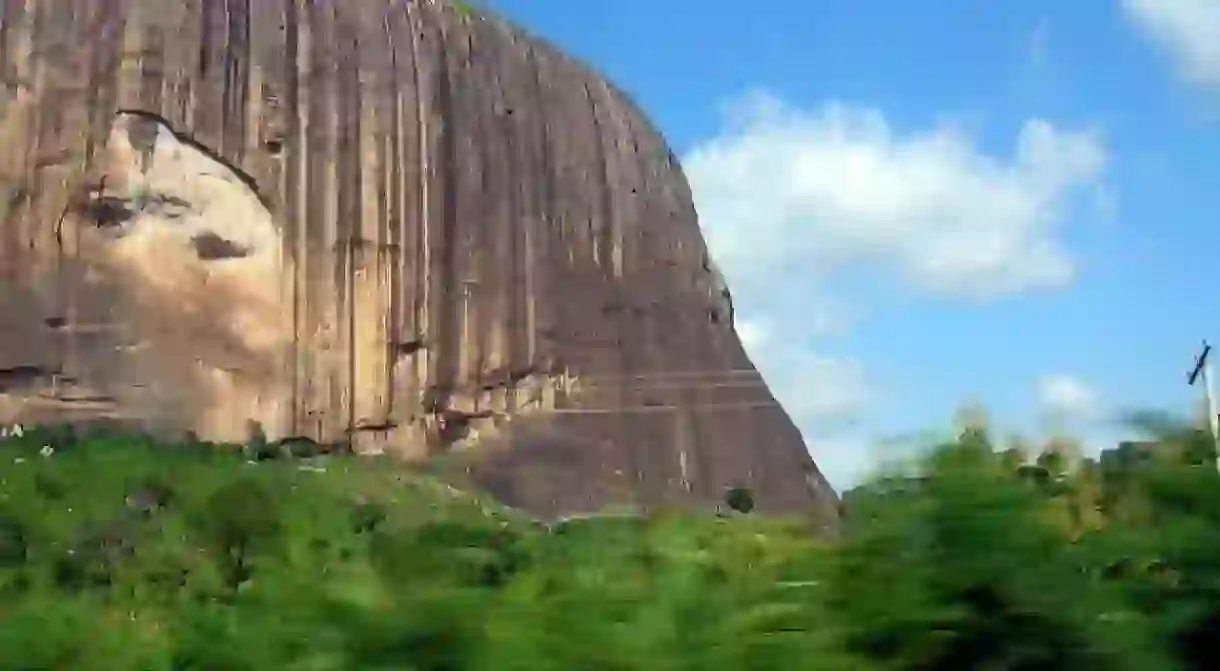Myths and Legends Surrounding Nigeria's Zuma Rock

It’s impossible to miss Zuma Rock – standing at 725 meters (2,379 ft), it majestically presides over the surrounding landscape. Visitors here will often notice that there is an unusual silence when travelling the highway in the area… Here’s why Zuma Rock is surrounded by myth and legends.
A rock with facial features
Yes you read right! Zuma Rock has natural contours on the surface which depict the image of a human face with a visible mouth, eyes, and nose. The natives of the community believe the face represents the deity and ancestral powers protecting and governing the affairs of the community. The Gwari people also acknowledge the rock as a gateway for the after life, It is believed that when people die, their spirits go to the rock.
The rock catches fire during the rainy season
The rainy season in Nigeria between April and October comes with another myth surrounding Zuma Rock – it is reported that the apex of the rock often catches fire. Natives attest the happenings to the wonders of the deities and voodoo spells. However, scientists object to the belief. Dr. Kistso Ngargbu, a geologist and lecturer at Nasarawa State University,Keffi, notes that:
“If it is after rainfall and a particular boulder or broken pieces of the rock got saturated with water, that’s the contact between heat and the main rock body. In the event that it had to slide because water now serves as a lubricating surface, friction is created. We should remember that our forefathers used to make fire from rocks glided against each other. That is what could have happened. Rain water got to the surface, lubricated the boulder and then generated a sliding probably based on a sloppy surface, and in the event of sliding down the fire came up”.
It served as a hideout against external forces
There is no precise account pertaining to the origin of the rock, however, Zuma Rock is said to have been first located in a thick forest by the people of Zuba in the 15th century upon the instruction of their soothsayer. The Zuba people named the rock, “Zumwa”, which means “the place of catching guineafowls” upon finding out that there were many within the forest. At their arrival in the forest, they settled around it and constructed settlements, and later discovered the spiritual representation of the rock as a powerful deity. They turned to worshipping and offering sacrifices to the rock to protect them and keep them safe from evil. Over time, the people of Gwari used the rock as a defense and hideout against invading neighboring tribes and external forces.
It protects against a disastrous outburst
Another yet interesting myth suggests that the Zuma Rock sits on a very large expanse of underground water. it is believed that if the rock is pulled down, there will be an outburst of water which will submerge an unimaginable land area.
Fun facts
The famous Zuma Rock features on Nigeria’s 100 Naira currency banknote.
It is twice as high as the Uluru Rock in Australia – it is also higher than the height of Nigeria’s popular Aso Rock and Olumo Rock put together, and more than four times as high as Nigeria’s tallest building, NECOM House.














